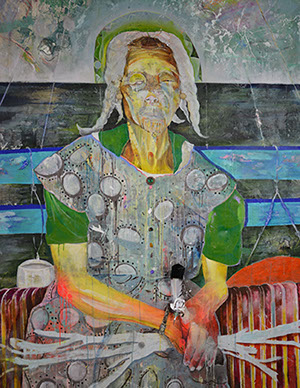
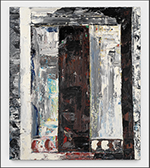

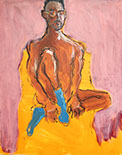
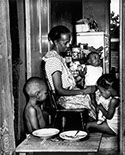
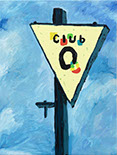
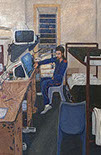
“Sometime Come to Someplace”
Lavar Munroe at Monique Meloche
by Annette LePique
In L. Frank Baum’s The Wonderful Wizard of Oz, Dorothy Gale, the story’s heroine, says to her compatriots, “if we walk far enough, we shall sometime come to someplace.” Dorothy here is referring to the characters’ journey to see the titular wizard. They don’t know quite where they’re going, but they have faith that they’ll find their way and find a place that means something; in other words, they have faith that there is a place for them. The Wiz, Baum’s story adapted to film by Sidney Lumet, updates Dorothy’s journey to take place in 1970s Harlem. Dorothy, played by Diana Ross, sets off to also find a place to call her own. Although with major flaws, Lumet’s adaptation is notable as it considers racial identity in relationship to economic class. Baum’s Dorothy was a rural farm kid in Kansas during America’s Great Depression, the idea of race was not mentioned. In contrast, the treatment of Diana Ross’ Dorothy was more complex. Ross’ Dorothy lived in, and traversed, parts of NYC derogatorily referred to as the ghetto and the color of her skin marked her as “other” in 1970s America. Though the film was hampered by a simplistic depiction of race, place, and class, at its heart lay a claim to the universality of home. Home is where kin, belonging, and love, prosper.
It is this complex, utopian, yet deeply felt, idea of home that guides artist’s Lavar Munroe’s body of work. In the materials accompanying his show, “Sometime Come to Someplace” at Monique Meloche gallery, there is a note regarding his own upbringing in the Bahamas. Munroe’s biography states that he sees his childhood, bold visual language, and interpretation of local folklore as a means to “challenge the stigma and judgment associated with the ghetto.” Munroe’s response, his critique to the intertwined assumptions surrounding race and class, provide a direct through line (in addition to the exhibition’s title) to thinking about ideas of homecoming, homesickness, and searching for home. These are all openings to explore the frictions and joys of family and history, and how the stories of such are writ large upon one’s personhood.
In his paintings, Munroe conveys the tensions inherent in the personal and the public, the mythic and the mundane, and in color, movement, and texture. There is much for the eye here, there is an inescapable grandeur in each piece. While some of this feeling stems from the scale of his pieces (many more than six feet tall), Munroe’s coiled intricacies, his attention to detail complicate these sensations of monument and memory. It’s memory that complicates, that twirls back within itself—the shadows of the times, places, experiences, and people that have brought the artist to this moment. “Sometime” is an exhibition concerned with the figure, the human, the people within the picture plane. These figures are the protagonists, the heroes, the adventurers, the Dorothy Gales’ of Munroe’s work. Munroe was inspired to create the exhibition from his recent travels to Zimbabwe. Using his childhood in the Bahamas and the aforementioned trip, Munroe incorporates both spaces in conversation with the mythic Oz. Munroe’s explorations of place are tactile, they engage all the senses. With color and texture, each piece tells a story.
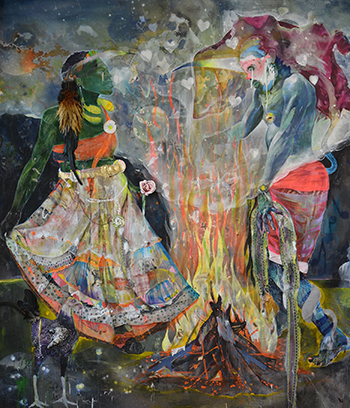 In You People With Hearts (2022) a woman and man dance with a fire at their feet. The woman’s skirt is a swirl of patchworked colors and textures; a petticoat the color of stained marmalade merges into a white and gray polka dot, which then shifts to a hem of interlocking triangles of pinks, blues, and yellows. The body of the skirt is a mass of faded, bright plaids and puddled color. One hand holds a rose, while the other lifts her skirt aloft. She looks at the man who concentrates on the flames, as shining pinpricks of embers dot their ankles and feet. The man is mid-step, heel aloft, dancing to a rhythm that echoes only for him and his partner, a song known only to nights and flames of freedom. Composed of chicken feathers, fabric, sheet music jewelry, and acrylic paints, the title of the piece comes from a line the character of the Tin Man says in The Wonderful Wizard of Oz. The Tin Man is expressing his caution at making choices and moving through the world without a heart. However, Munroe subverts the meaning of the line, as viewers are the ones who speak the line in reference to the dancers. The dancing couple are the people with hearts, while the viewer must decide for themselves where their heart resides.
In You People With Hearts (2022) a woman and man dance with a fire at their feet. The woman’s skirt is a swirl of patchworked colors and textures; a petticoat the color of stained marmalade merges into a white and gray polka dot, which then shifts to a hem of interlocking triangles of pinks, blues, and yellows. The body of the skirt is a mass of faded, bright plaids and puddled color. One hand holds a rose, while the other lifts her skirt aloft. She looks at the man who concentrates on the flames, as shining pinpricks of embers dot their ankles and feet. The man is mid-step, heel aloft, dancing to a rhythm that echoes only for him and his partner, a song known only to nights and flames of freedom. Composed of chicken feathers, fabric, sheet music jewelry, and acrylic paints, the title of the piece comes from a line the character of the Tin Man says in The Wonderful Wizard of Oz. The Tin Man is expressing his caution at making choices and moving through the world without a heart. However, Munroe subverts the meaning of the line, as viewers are the ones who speak the line in reference to the dancers. The dancing couple are the people with hearts, while the viewer must decide for themselves where their heart resides.
In the exhibition’s titular work, Sometime Come to Someplace (2022), centered in the frame is the figure of an elder. Her gray braids are haloed by a tight head covering of phosphorescent green. Flaring out from her right eye, pearled with blindness, is a small golden gray orb. The framing of the woman is tight, she is posed as though she is sitting for a portrait. Only her torso, her lap, and arms are visible. In her hands, she holds a rose, a feather, and a small bundle of sticks. Behind her is the outline of two parallel wooden slats, illuminated in a twisting, cerulean blue. A dusting of milky paint drips rain throughout the picture plane. This may be a portrait, this may be a memory, or this may be a wish fulfilled. I say this because popular lore indicates Baum dedicated the character of Dorothy to either his wife, a dreamer and adventurer who was hamstrung by the prohibitions of the era, or a beloved niece. This is not to suggest that the woman in the frame has any familial connection to Munroe, but rather that Dorothy’s heroines appear at any age and any race. Perhaps “Sometime Come to Someplace” is not just an ode to Dorothy, but a reminder that she, like Munroe, found her way home.
Lavar Munroe, Sometime Come to Somplace, 2022. Acrylic, spray paint, oil pastels, glass, earrings, wrist watch, feather, lace and synthetic rose on canvas, 76 x 60 inches. Photo: Monique Meloche Gallery.
Annette LePique is an arts writer. Her interests include the moving image and psychoanalysis. She has written for Newcity, ArtReview, Chicago Reader, Stillpoint Magazine, Spectator Film Journal, and others.
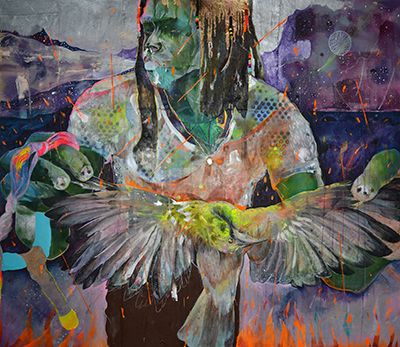
Lavar Munroe, We People Of Flesh and Blood, 2023. Acrylic, oil pastels, earrings, beads and feathers on canvas, 42 x 50 inches. Photo: Monique Meloche Gallery.
Lavar Munroe, You People With Hearts, 2022. Acrylic, chicken feathers, fabric, music sheet, jewelry and spray paint on canvas 92 x 84 inches. Photo: Monique Meloche Gallery.
